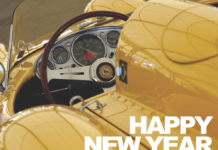By 1964, John Willment had become established as a successful race team owner. In addition to his large Ford dealership, he began racing Ford saloons such as the Lotus Cortina as American muscle cars in the form of the huge 7-litre Ford Galaxie. He was also flew the Ford banner in sports car events with the new AC Cobra. The team acquired three Cobras including both cars that took part in the 1963 Le Mans 24 hour endurance race as well as the ‘spare’.

Willment was also able to purchase a spare, un-numbered, chassis from AC Cars that would be part of the team’s spares inventory
At the same time, Shelby American had unveiled a new FIA-legal varitation of the Cobra clothed in new aerodynamic bodywork since, due to the shape of the bodywork, the Cobra roadster had the aerodynamics of a brick. Although it was quick, top speed was limited to around 165mph even with a hardtop in place. Making use of a loophole in the sporting regulations regarding bodywork (also used by Enzo Ferrari) in late 1963 a Cobra chassis became the basis for a streamlined coupe that made its debut at Daytona early in 1964. Although it was referred to as a Cobra Coupe, its Daytona association became inextricably linked with the car. John Willment realised that this was the way to win races so he approached Shelby with a request to buy one but this was rejected. Never one to walk away from a challenge, Willment decided he would build his own coupe based on the spare chassis.

Work began using drawings supplied by Shelby with the initial construction overseen by Shelby employee John Ohlsen who had returned to the UK early in 1964 to get married. John was one of the very few Shelby employees who built the first Daytona; everyone else thought it would be a disaster due to its radical shape. Shortly after work began Shelby told him to return to California. The craftsmen, some hired from Aston Martin, made several alterations and decided to lower and flatten the roofline to aid airflow. This in turn led to the doors, windows, windscreen, rear bodywork and tail section being different to the Daytona. When Peter Brock saw the car he admitted he had intended to create a similar roofline but rules and the bodywork fabricators resulted in the now familiar Daytona outline; in fact every coupe differed slightly as the following five coupes had bodywork handmade in Italy where the panel beaters ignored the drawings and worked by eye, beating the aluminium panels over old tree stumps.


Painted in Willment team colours of red with white centre stripes, the car was finished in August, too late to compete at Le Mans. It carried the chassis number CSX2131, close to that of another team Cobra, 39PH which Willment registered as CS2131. (This proved useful when shipping the cars overseas on import/export carnets). Its first event was a 3-Hour race at Snetterton where Jack Sears won by a huge margin having driven through pouring rain and thick fog. As Sears owned a farm a few miles from the circuit, he could have won with his eyes closed as he knew every inch of the track by heart. The coupe was entered in several major sports car races in the UK driven either by Sears, Frank Gardner or Bob Olthoff. It was the South African driver Olthoff who took the car to take part in the Springbok race series in his home country during the UK winter. When the coupe returned to the UK for the 1965 season, it was already uncompetitive, its best result being 10th overall at the Oulton Park Gold Cup. Its final race for the Willment team took place in 1966 but by then John Willment had turned his attention elsewhere, forming JW Automotive with John Wyer. The successful but short-lived Willment team closed it doors.

The coupe was sold to George Pitt who used it on both road and track, registered 39PE, competing in historic sports club races including the final meeting at Crystal Palace in 1972. In 1976 it was sold to Amschel Rothschild who continued to race the car in club events before, in 1980, it was sold to a collector in the USA. Over the years it changed hands several times before, in 1999, it was acquired by Larry Miller to join the huge Ford-based collection housed at his own museum in Utah. Luckily he was not averse to exercising his cars and the Willment coupe crossed the Atlantic to take part in the Goodwood Revival in 2004. When Larry passed away, the museum loaned many of its cars and today the coupe is on display at the Shelby American Collection in Boulder, Colorado.


Track shots of the Willent coupe during the 2004 RAC TT race, Goodwood Revival















